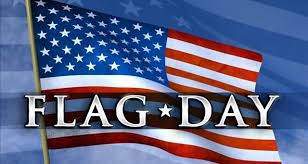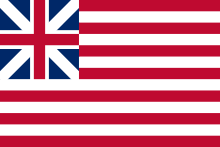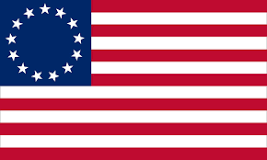
INDIANA- The Stars and Stripes. Old Glory. The Star Spangled Banner. No matter what you call it, the American flag symbolizes our unity and celebrates the freedom it represents. The first flag resembling the modern stars and stripes was unofficial, sometimes called the Grand Union Flag or “the Continental Colors.” It consisted of 13 red-and-white stripes, with the Union Jack in the upper left-hand corner. It first appeared on December 3, 1775, when Continental Navy Lieutenant John Paul Jones flew it aboard Captain Esek Hopkin’s flagship, Alfred, in the Delaware River.[5] It remained the national flag until June 14, 1777.[6] At the time of the Declaration of Independence in July 1776, there were no flags with any stars; the Second Continental Congress did not adopt flags with “stars, white in a blue field” for another year. The “Grand Union Flag” has historically been referred to as the first national flag of the United States.

The first official U.S. flag flown during battle was on August 3, 1777, at Fort Schuyler (Fort Stanwix) during the Siege of Fort Stanwix. Massachusetts reinforcements brought news of the adoption by Congress of the official flag to Fort Schuyler. Soldiers cut up their shirts to make the white stripes; scarlet material to form the red was secured from red flannel petticoats of officers’ wives, while material for the blue union was secured from Capt. Abraham Swartwout’s blue cloth coat. A voucher is extant, and Congress paid Capt. Swartwout of Dutchess County for his coat for the flag.

In 1795, the number of stars and stripes was increased from 13 to 15 (to reflect the entry of Vermont and Kentucky as states of the Union). For a time, the flag was not changed when subsequent states were admitted, probably because it was thought this would cause too much clutter. It was the 15-star, 15-stripe flag that inspired Francis Scott Key to write “Defence of Fort M’Henry”, later known as “The Star-Spangled Banner”, which is now the American national anthem. The flag is currently on display in the exhibition “The Star-Spangled Banner: The Flag That Inspired the National Anthem” at the Smithsonian Institution National Museum of American History in a two-story display chamber that protects the flag while it is on view.[57]
On April 4, 1818, Congress passed a plan at the suggestion of U.S. Naval Captain Samuel C. Reid. The plan changed the flag to have 20 stars, with a new star added when each new state was admitted. However, the number of stripes would be reduced to 13 to honor the original colonies. The act specified that new flag designs should become official on the first July 4 (Independence Day) following the admission of one or more new states.
In 1912, the 48-star flag was adopted. This was the first time that a flag act specified an official arrangement of the stars in the canton, namely six rows of eight stars each, where each star would point upward. However, the U.S. Army and U.S. Navy have already been using standardized designs. Throughout the 19th century, different rectangular and circular star patterns were abundant in civilian use.
The current 50-star flag was adopted in 1960, incorporating the most recent change, from 49 stars to 50, when the present design was chosen after Hawaii gained statehood in August 1959. Before that, the admission of Alaska in January 1959 had prompted the debut of a short-lived 49-star flag.
When Alaska and Hawaii were considered for statehood in the 1950s, more than 1,500 designs were submitted to President Dwight D. Eisenhower. Although some were 49-star versions, the vast majority were 50-star proposals. At least three of these designs were identical to the present design of the 50-star flag. At the time, credit was given by the executive department to the United States Army Institute of Heraldry for the design. The 49- and 50-star flags were each flown for the first time at Fort McHenry on Independence Day in 1959 and 1960, respectively. A popular myth is that an Ohio teenager and later mayor of Napoleon, Ohio, named Robert G. Heft had designed the 50-star flag, but this was debunked by Alec Nevala-Lee in his investigative article “False Flag” on June 30, 2022. Before the article’s publication, numerous sources, including Wikipedia, cited the myth as fact.[62]
On July 4, 2007, the 50-star flag became the longest-used version, surpassing the 48-star flag used from 1912 to 1959.







.png)











